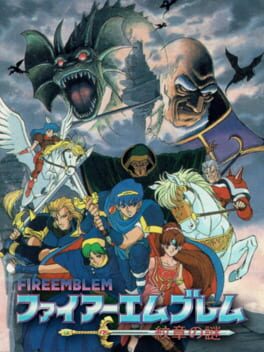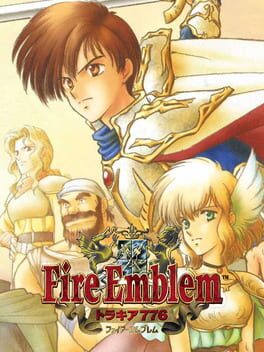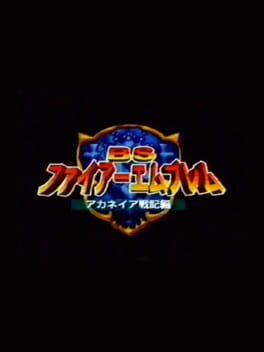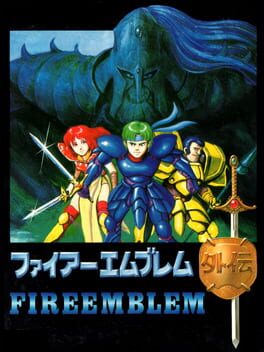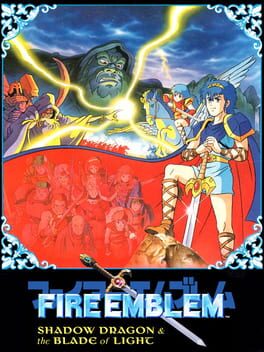

Fire Emblem: Monshou no Nazo (translated as Fire Emblem: Mystery of the Emblem in Fire Emblem: Awakening) is a Japanese tactical role-playing game developed by Intelligent Systems and published by Nintendo. It is the third game in the Fire Emblem series and was released in Japan on January 21, 1994. It was the first Fire Emblem title for the Nintendo Super Famicom and the first twenty-four-megabit cartridge for the system. The game is divided into two distinct parts, or "books". Book One is a remake of the original Fire Emblem: Shadow Dragon and the Blade of Light, and Book Two is a continuation of events, following the same characters.
Also in series
Released on
Genres
Reviews View More
This game has a lot of charm, that's undeniable. There's just something about the antiquated yet appealing aesthetic, limited quality of life and the utilitarian approach to character growth. This is Fire Emblem in its purest form, where every iron man run almost feels as canon as the rest. There's a story to play and a war to win sure, but this isn't rewarded solely by whichever arbitrary warriors are granted the most fortunate RNG. To save the world everyone's help is needed and adapting on the fly may be the necessity to receive the utmost enjoyment.
FE3 is an old school game, and that is just as much a positive as a negative in this case. Let's look at both books, clocking in at roughly an impressive 20-25 hours each respectively to explore what both games' positives and major flaws are that almost allow this game primitive game to hold an infectious appeal.
Book One
I feel that in many senses this is a journey and war of the common man. There's a big intention of making this war feel like an adventure of an ill-fated prince tasked with the impossible: Forming an army to match one seeking dominion over the world. The identity this game has is extremely on point, the dialogue even acknowledges that this isn't Marth's fight to fight alone and it's reflected in the gameplay. Marth is not your strongest fighter, nor your weakest, but his utility is essential. Without Marth, there is no army and no objective, yet he can't fight alone.
The fantastic thing about FE3 as a whole that allows its intentions to ring so clearly is one simple thing: 20 is the stat cap all around, barring HP which is at 52. Some units don't class change, some have poor stats, or their availability may not be the best. But every single caveat in response presents an opposing incentive. Some units don't class change? Thieves can pick locks, Fighters use axes the hardest hitting weapon type, Dragons have insanely high stats as long as you have a firestone and so on. Poor stats? Low stat cap, so it's hardly an issue. The amount of stat boost drops in this game can completely manufacture a terrible unit into a powerhouse if you so desire. You want that unlikely Cord or Matthis hero story? Go right for it. Did you just get a unit halfway into the game that doesn't fit in the roster? Well just pray you can keep playing well so that your units don't die, else you have to suddenly rely on an unlikely character.
Book One is the quintessential Fire Emblem game that encourages you to not reset. This is a no-brainer to more experienced players, but casual players like myself will never not hate having to part with a character simply due to a mistake, lack of knowledge, etc. It especially hurts introspectively when Book Two doesn't kill anyone off in-between games. But these aren't two playthroughs connected by the serendipity of of video game magic, you have a story to overcome here and one yet to come that presents a different scenario. Nothing more.
Okay, so what does Book One fucking suck at? It goes without saying the map designs are poor. Some are fine, especially the first few and some of the latter half chapters pick up the slack but this game is absolutely agonising to play a good half the time. Be prepared to have a whole lot of nothing happening as you trudge your units through grass fields seemingly made of cement, praying that it could go just a little faster. It also doesn't help that maps have a tendency to either frontload you with enemies or make you take your sweet time to finally make contact and hope Cain or Abel will last through a barrage of cavaliers and horsemen.
On that topic is a problem that's as big as the map designs: Class disparity. You want to use an armoured unit like Draug, even though you know he sucks? Your fucking funeral buddy, cause that dude moves 4 goddamn spaces per turn. A cavalier moves 9, paladins move 10. Is Draug a mediocre unit? Sure, his stats aren't great. But as prior established it's not his stats, it's his abysmal class in a game filled to the brim with giant maps. Put simply, Draug or any other armour unit isn't going to fight in any map that requires you to play remotely offensive. This is a topic that's technically universal to Fire Emblem as a whole but it's felt even more in the earlier games where the game just doesn't seem to understand nor respect the inherent differences of each class. Of course Draug should be slow, the idea is perfectly sound. But when you're playing a game that requires you to constantly move and fight - in that specific order - If your unit has less movement speed, it is objectively worse by that sole virtue.
Are mages and archers also slow? Absolutely, but even they have their benefits. Reach level 10 and an archer can promote into a sniper, being able to move 7 spaces with massive stat boosts. Mages strike at resistance, a stat that units rarely have thus allowing them to almost always hit for full damage. They also gain staves on promotion so keeping up with the frontline isn't always necessary.
Now I will give FE3 some credit, cause they did find a way to indirectly nerf movement which is by dismounting all units with high movement on indoor chapters. It sounds like a gimmick but it's far more prevalent than you may expect and could even force you to move your team around when you encounter a chapter like this. Suddenly your powerhouses Abel and Cain may be just another swordfighter when a trained Ogma or Barst are wrecking everything left and right. It could be time for Julian to go lock picking instead, or to finally let that stupid bastard Draug get some fighting done now that the map's a little smaller. On one hand it's lame that dismounting feels almost pointless outside of needing to besides managing weapon durability, but it's nice that an entry this old could recognise the flaw of too much of a good thing that mounted units offer.
Book One's true flaw lies in its lack of polish, unsurprisingly so due to its faithful adaptation of the NES game. But where it succeeds grants it a strong identity. It's a fine Fire Emblem game and while there are many better options, it offers an experience that separates itself from a contemporary like the Binding Blade with its distinctive style of the time.
Book Two
Book Two almost feels like a perfect course correction. Almost. But that "almost" is a big, big factor. Almost all maps in this game are designed better allowing slower units to contribute more often, unit availability feels more considered with even the most useless late game additions having benefits to the player if you need a backup plan or simply have a strategy in mind. It almost feels like it fixes practically everything and is an all around more challenging and gratifying experience. But there are some serious flaws that come with the intention to course correct.
Ironically, the first problem I find with this game's attempt at fixing Book One's problems is how shoddy it can be. The level design is generally better yes, but the lows can be shockingly low. Everyone dreads chapter 3 for a reason wherein you spend a solid 5 minutes doing absolutely nothing but moving your units to rendezvous with an isolated Palla. If you want to use an archer which is more viable in Book Two due to the overall smaller maps this map will make you hate everything. It takes so fucking long for Ryan or Gordin to reach the top of the screen to the point that it's an absolute joke.
Herein lies a problem that can perhaps be a little less evident the more you play through this and may be a little controversial, but the Starspheres create a lot of problems that go against the ideas of Book One. This is the first time in the franchise where the game tries to give you more control over how your units will grow rather than relying on RNG, but it's also an essential element to getting the true ending. That's fine, but when played in tandem with another part that involves the survival of many specific characters throughout the game that it creates a game that can demand a lot while leaving you ill-prepared in doing so.
When it comes to difficulty this game is an absolute cakewalk for like 90% of its run. Then it decides in the last few chapters to throw so much RNG reliant scenarios at you that you basically need to have every barrier staff throughout the game on hand so prevent your units from being one shot by global magic. This is like, a game where magic defense is nonexistent, yet at some point it decides to fuck that off and make you contend with magic that hits so hard and from so far away that you just have to hope a unit doesn't get one shot. By removing many of the stat boosts in favour of growth manipulation, this ends up forcing favouritism into your playthroughs far more than Book One while also dealing with a condition to reach the true ending.
Basically, this game has a clear blueprint that in theory is great, but honestly is fighting against FE3's own logic. Book One is FE3 at its core and while Book Two is technically way better, it feels like a completely different game working within the exact same engine. My problems with Book Two aren't its innovation, I actually really like its ideas. But it's honestly so different to the first book that they never should have been on one cartridge.
Conclusion
I may add to this review in the future considering I sort of ran out of steam near the end. Basically, I like this game but I also really hate some things in it. Both books are flawed but it's obvious that there's a clear identity for both, they just don't belong in the same game in my opinion.
FE3 is an old school game, and that is just as much a positive as a negative in this case. Let's look at both books, clocking in at roughly an impressive 20-25 hours each respectively to explore what both games' positives and major flaws are that almost allow this game primitive game to hold an infectious appeal.
Book One
I feel that in many senses this is a journey and war of the common man. There's a big intention of making this war feel like an adventure of an ill-fated prince tasked with the impossible: Forming an army to match one seeking dominion over the world. The identity this game has is extremely on point, the dialogue even acknowledges that this isn't Marth's fight to fight alone and it's reflected in the gameplay. Marth is not your strongest fighter, nor your weakest, but his utility is essential. Without Marth, there is no army and no objective, yet he can't fight alone.
The fantastic thing about FE3 as a whole that allows its intentions to ring so clearly is one simple thing: 20 is the stat cap all around, barring HP which is at 52. Some units don't class change, some have poor stats, or their availability may not be the best. But every single caveat in response presents an opposing incentive. Some units don't class change? Thieves can pick locks, Fighters use axes the hardest hitting weapon type, Dragons have insanely high stats as long as you have a firestone and so on. Poor stats? Low stat cap, so it's hardly an issue. The amount of stat boost drops in this game can completely manufacture a terrible unit into a powerhouse if you so desire. You want that unlikely Cord or Matthis hero story? Go right for it. Did you just get a unit halfway into the game that doesn't fit in the roster? Well just pray you can keep playing well so that your units don't die, else you have to suddenly rely on an unlikely character.
Book One is the quintessential Fire Emblem game that encourages you to not reset. This is a no-brainer to more experienced players, but casual players like myself will never not hate having to part with a character simply due to a mistake, lack of knowledge, etc. It especially hurts introspectively when Book Two doesn't kill anyone off in-between games. But these aren't two playthroughs connected by the serendipity of of video game magic, you have a story to overcome here and one yet to come that presents a different scenario. Nothing more.
Okay, so what does Book One fucking suck at? It goes without saying the map designs are poor. Some are fine, especially the first few and some of the latter half chapters pick up the slack but this game is absolutely agonising to play a good half the time. Be prepared to have a whole lot of nothing happening as you trudge your units through grass fields seemingly made of cement, praying that it could go just a little faster. It also doesn't help that maps have a tendency to either frontload you with enemies or make you take your sweet time to finally make contact and hope Cain or Abel will last through a barrage of cavaliers and horsemen.
On that topic is a problem that's as big as the map designs: Class disparity. You want to use an armoured unit like Draug, even though you know he sucks? Your fucking funeral buddy, cause that dude moves 4 goddamn spaces per turn. A cavalier moves 9, paladins move 10. Is Draug a mediocre unit? Sure, his stats aren't great. But as prior established it's not his stats, it's his abysmal class in a game filled to the brim with giant maps. Put simply, Draug or any other armour unit isn't going to fight in any map that requires you to play remotely offensive. This is a topic that's technically universal to Fire Emblem as a whole but it's felt even more in the earlier games where the game just doesn't seem to understand nor respect the inherent differences of each class. Of course Draug should be slow, the idea is perfectly sound. But when you're playing a game that requires you to constantly move and fight - in that specific order - If your unit has less movement speed, it is objectively worse by that sole virtue.
Are mages and archers also slow? Absolutely, but even they have their benefits. Reach level 10 and an archer can promote into a sniper, being able to move 7 spaces with massive stat boosts. Mages strike at resistance, a stat that units rarely have thus allowing them to almost always hit for full damage. They also gain staves on promotion so keeping up with the frontline isn't always necessary.
Now I will give FE3 some credit, cause they did find a way to indirectly nerf movement which is by dismounting all units with high movement on indoor chapters. It sounds like a gimmick but it's far more prevalent than you may expect and could even force you to move your team around when you encounter a chapter like this. Suddenly your powerhouses Abel and Cain may be just another swordfighter when a trained Ogma or Barst are wrecking everything left and right. It could be time for Julian to go lock picking instead, or to finally let that stupid bastard Draug get some fighting done now that the map's a little smaller. On one hand it's lame that dismounting feels almost pointless outside of needing to besides managing weapon durability, but it's nice that an entry this old could recognise the flaw of too much of a good thing that mounted units offer.
Book One's true flaw lies in its lack of polish, unsurprisingly so due to its faithful adaptation of the NES game. But where it succeeds grants it a strong identity. It's a fine Fire Emblem game and while there are many better options, it offers an experience that separates itself from a contemporary like the Binding Blade with its distinctive style of the time.
Book Two
Book Two almost feels like a perfect course correction. Almost. But that "almost" is a big, big factor. Almost all maps in this game are designed better allowing slower units to contribute more often, unit availability feels more considered with even the most useless late game additions having benefits to the player if you need a backup plan or simply have a strategy in mind. It almost feels like it fixes practically everything and is an all around more challenging and gratifying experience. But there are some serious flaws that come with the intention to course correct.
Ironically, the first problem I find with this game's attempt at fixing Book One's problems is how shoddy it can be. The level design is generally better yes, but the lows can be shockingly low. Everyone dreads chapter 3 for a reason wherein you spend a solid 5 minutes doing absolutely nothing but moving your units to rendezvous with an isolated Palla. If you want to use an archer which is more viable in Book Two due to the overall smaller maps this map will make you hate everything. It takes so fucking long for Ryan or Gordin to reach the top of the screen to the point that it's an absolute joke.
Herein lies a problem that can perhaps be a little less evident the more you play through this and may be a little controversial, but the Starspheres create a lot of problems that go against the ideas of Book One. This is the first time in the franchise where the game tries to give you more control over how your units will grow rather than relying on RNG, but it's also an essential element to getting the true ending. That's fine, but when played in tandem with another part that involves the survival of many specific characters throughout the game that it creates a game that can demand a lot while leaving you ill-prepared in doing so.
When it comes to difficulty this game is an absolute cakewalk for like 90% of its run. Then it decides in the last few chapters to throw so much RNG reliant scenarios at you that you basically need to have every barrier staff throughout the game on hand so prevent your units from being one shot by global magic. This is like, a game where magic defense is nonexistent, yet at some point it decides to fuck that off and make you contend with magic that hits so hard and from so far away that you just have to hope a unit doesn't get one shot. By removing many of the stat boosts in favour of growth manipulation, this ends up forcing favouritism into your playthroughs far more than Book One while also dealing with a condition to reach the true ending.
Basically, this game has a clear blueprint that in theory is great, but honestly is fighting against FE3's own logic. Book One is FE3 at its core and while Book Two is technically way better, it feels like a completely different game working within the exact same engine. My problems with Book Two aren't its innovation, I actually really like its ideas. But it's honestly so different to the first book that they never should have been on one cartridge.
Conclusion
I may add to this review in the future considering I sort of ran out of steam near the end. Basically, I like this game but I also really hate some things in it. Both books are flawed but it's obvious that there's a clear identity for both, they just don't belong in the same game in my opinion.
Despite not looking spectacular like the Jugdral games, Mystery is an entertaining game, and with elements that Kaga would use in his later games. including separating the plot into two arcs, or dismantling. Although Jugdral's games are great, Mystery deserves respect, and don't forget the following. Before Awakening, Mystery had the feat of being the best-selling FE in its country of origin.
A great time, it was super fun to finally understand Marth’s story. It was a great time and really fun to build an army in, especially during book 2 with star shard shenanigan.
It was hard though, and when it felt hard there were moments were I felt a bit unfair. One of the few FE games I had to let characters I really like stay dead just to get by, which I actually really loved.
It was hard though, and when it felt hard there were moments were I felt a bit unfair. One of the few FE games I had to let characters I really like stay dead just to get by, which I actually really loved.
I weirdly enjoy the abridged version of Book 1, the lack of a few characters and chapters is kinda funny because it also forces to move a few units around.
Book 2 was kind of awesome, the surprising difficulty early on + the mixup of unit's availability was cool. New music is great (Big fan of Off to War), and the last few chapters were tough in a good way. Star shards were very cool and the Again staff is unapologetically broken which I love.
Main drawbacks overall are:
- Music in Book 1 kinda sucks
- The arc of the midgame where you only fight dragons was a bit of a slog. Had to stop for a while since it was getting monotonous
- Not crazy about endgame only giving you 2 weapon types to choose from. With minimal exceptions to Bows (4 users in total) and Lances (2 only for indoors)
Book 2 was kind of awesome, the surprising difficulty early on + the mixup of unit's availability was cool. New music is great (Big fan of Off to War), and the last few chapters were tough in a good way. Star shards were very cool and the Again staff is unapologetically broken which I love.
Main drawbacks overall are:
- Music in Book 1 kinda sucks
- The arc of the midgame where you only fight dragons was a bit of a slog. Had to stop for a while since it was getting monotonous
- Not crazy about endgame only giving you 2 weapon types to choose from. With minimal exceptions to Bows (4 users in total) and Lances (2 only for indoors)
